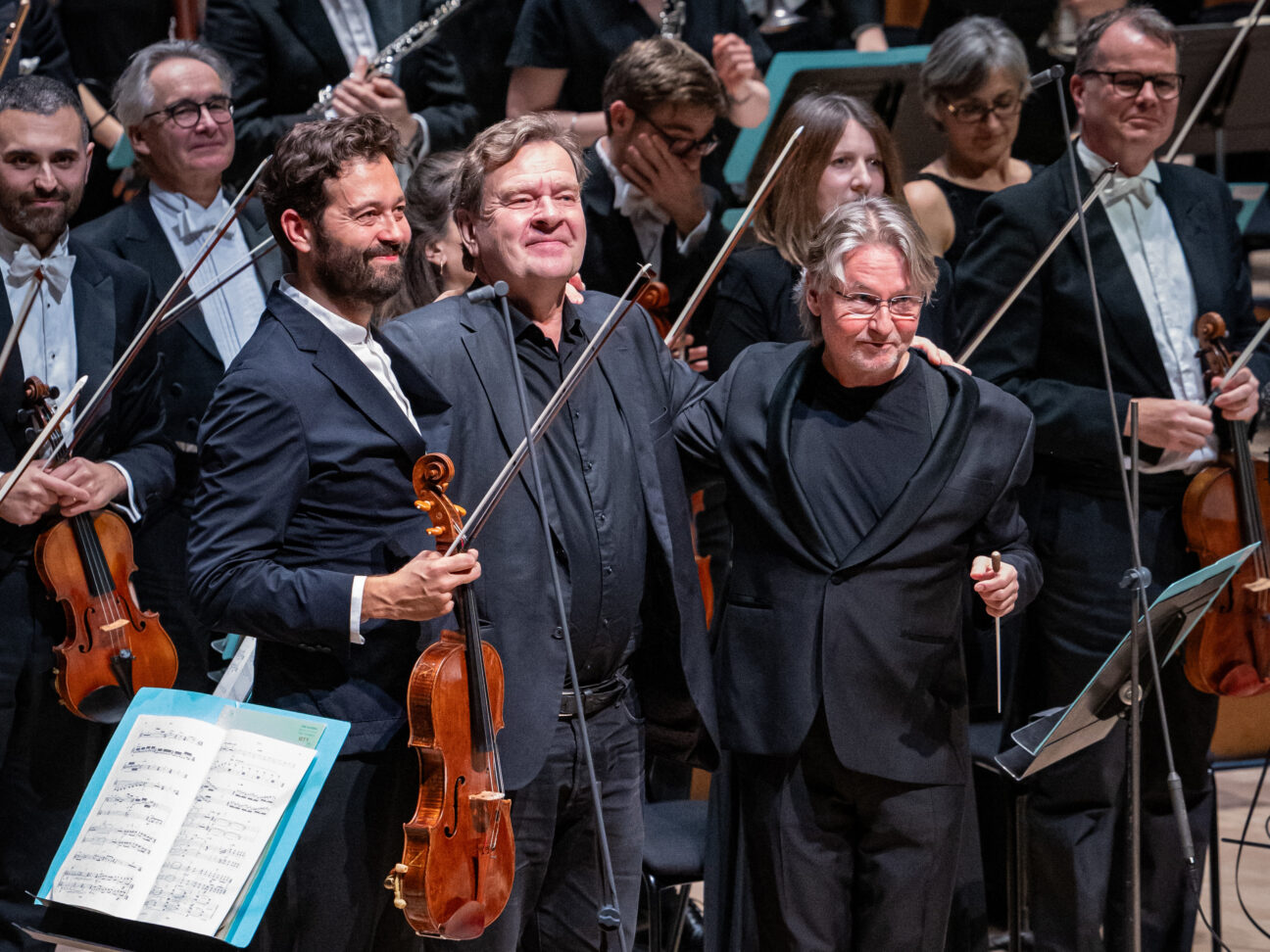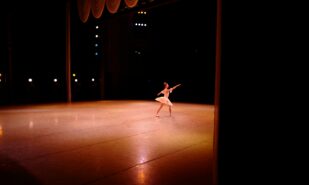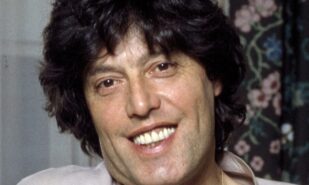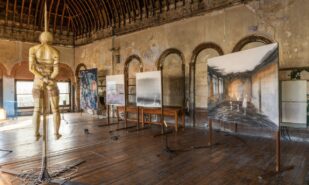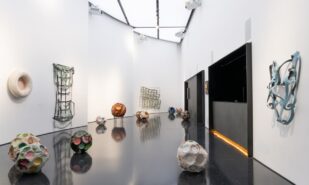Finnish composer Magnus Lindberg was born in 1958, and studied in Helsinki and Paris, working with various experimental music collectives such as Korvat Auki, Toimii (Finland), IRCAM and Ensemble Intercontemporain (Paris). He has been a Composer-in-Residence with the New York Philharmonic (2009-2012) and the London Philharmonic Orchestra (2014-2018). We met with Magnus on the 10th of November 2024 to talk about the British premiere of his new Viola Concerto with Lawrence Power and the Philharmonia Orchestra.
Finnish composer Magnus Lindberg in conversation about his new Viola Concerto and being part of the Nordic Soundscapes series
London Cult.: Magnus, your concert is finishing the series of Nordic Soundscapes and I wonder were you part of the curating team for this program? Or were you just asked to be part of it as a composer? Could you tell us more about your participation in this wonderful series of concerts?
Magnus Lindberg: I have not been part of any curator group creating them, but when my viola concerto was commissioned, we had its premiere on February 28 in Helsinki, Finland, there was also a Finnish lady living in Aix-en-Provence, who is the owner of the violinist Lawrence Power’s instrument and a person supporting Lawrence very much in his artistic world. Gina put in money for the commission of the piece and she put in the money for having the piece played here in London with the Philharmonia. And as conductor Esa-Pekka Salonen was involved with the Philharmonia, they thought that this could be a beautiful comeback for me. It has been more than 20 years since I have last worked with the Philharmonia. I have been a resident of the London Philharmonic Orchestra, and in the meantime my works have been played by the London Symphony Orchestra and also by the BBC, so the comeback now with the Philharmonia is really beautiful for me, because I have so good memories from the time we worked together. It was in 2003 I think, it was a tour of my orchestral piece Kraft in London, Paris, and other cities. It was performed by Philharmonia and Esa-Pekka Salonen, as he was the orchestra’s Principal Conductor.
LC: I remember that there are not so many viola concertos, but there are a few. Were you aware of them when you were writing yours?
ML: Yeah, it’s not an instrument that has had the same exposure as the violin or the piano or even the cello. So the repertoire of viola concertos is a bit limited. And the original setup of all this was actually my idea, because I have written two concertos for cello and I have written two concertos for violin, and I always wanted to do a viola concerto because I simply love that instrument, the colour, the timbre you have on the viola. Today the viola is a very agile instrument, you can play everything on the viola. So it’s a beautiful instrument and I really wanted to do this.
And it all worked out also because of Nicholas Collon who is now the Principal Conductor of the Finnish Radio Orchestra, and he is a good friend of Lawrence Power. Nicholas actually was a viola player, and is a viola player himself. So Lawrence and Nick being friends made it the perfect combo and of course for me today getting the possibility to write for this younger generation is very important. We are one generation apart with Lawrence and Nick, and nothing can be more rewarding for a composer of my age than having young musicians being interested in what we are doing. For me that was one of the most natural and beautiful things about this. I came up with a big piece. It’s 34 minutes long depending on how long the cadenza is. Lawrence is always improvising a cadenza.
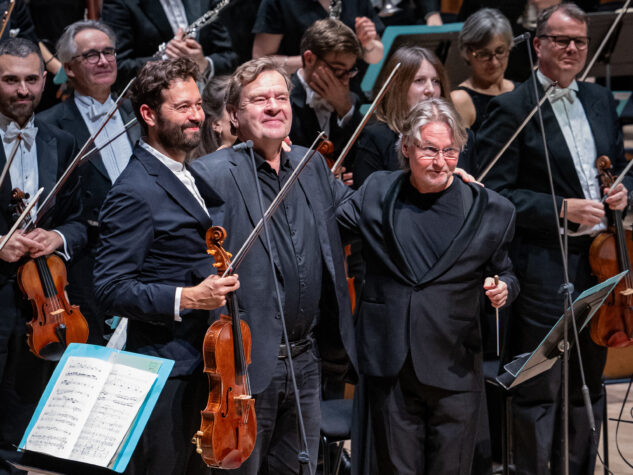
LC: Do you think that your concert would boost his career as a viola player and a soloist?
ML: I definitely think it’s his position as a soloist because Lawrence is the absolute star of the viola today (among a few other top musicians) and I think it was beautiful that the Philharmonia wanted to do this concerto. We also have upcoming performances with it – in spring there will be the Elbphilharmonie one with Alan Gilbert who was also part of the commission, and there will be St. Louis Orchestra, as the US was also part of the commissioning body. Lawrence is already planning to play the concerto in Glasgow and he will play it in Austria. So it’s definitely so, but all credit goes to Lawrence as a soloist.
LC: So in a way your work helps channelling his talent.
ML: I hope so, yes. And he will be travelling. He’s genuinely interested in premiering new concertos. I think that’s fantastic to have someone like him working for the viola to get more exposure for the instrument in various concerts.
LC: Have you had input from him as the instrumentalist in the process of writing your concerto?
ML: We have met several times, yes. We met during the process, but not as much as I did previously with my first Cello Concerto. With Anssi Karttunen we worked note by note on that project, the same I did with my Clarinet Concerto with Kari Kriikku – we really worked and tailored it note by note.
It was different with my Violin concertos. My number one was for Lisa Batiashviili, and I delivered her a ready score and then I made some trimming, but nothing serious. The same was with the second Violin Concerto with Frank Peter Zimmermann. We trimmed certain things but not so much. And my three Piano Concertos stand very much apart from each other, because the first one is already more than 30 years old, it dates back to 1991.
In those days the premiere was with Paul Crossley who is a wonderful pianist, and he also was the artistic director of the London Sinfonietta. So we talked about piano playing with him, and of course Paul was and still is a good friend of mine. We talked with him, and then I wrote the piece. Piano is also my own instrument. So I have some thoughts about how to write for the piano. With the Second Piano Concerto – it was for Yefim Bronfman, whom I have known for a long time, he is a friend. He’s also a good friend of Esa-Pekka Salonen. So with that concerto I delivered the solo part to Yefim, and he just nailed it in an amazing way. Yuja Wang was the performer of the third one, it was written in 2022-2023. We met during my work and looked at some of the writing, and I just realized that despite her playing all the Rachmaninoff and Prokofiev concertos, she has a small hand. I have always been writing big chords because I am the kind of Rachmaninoff person with big hands. So I thought why should I write a Concerto with big chords for someone like Yuja. So I took them all out.
LC: So it means you changed it specifically for her?
ML: Yes, indeed. But Yuja does everything with her small hands, of course she plays all kinds of repertoire, she can almost inaudibly arpeggiate long chords, so that’s not a problem. But this was definitely tailored for her.
LC: Are there technicalities of viola that you were aware of when you adjusted the Concerto for Lawrence?
ML: Yes, indeed. When we met in Paris and I had barely started to work on the Concerto, he showed me what he can play. He has huge hands, he’s a kind of person similar to me in this respect. He can play chords that would not be considered classical repertoire for the viola. Also Lawrence’s experience with baroque music also influenced the way I was working on the Concerto. So I hope the viola concerto is distinctively different from my other string Concertos because it’s personalized deliberately for Lawrence Power.
LC: Is there a way one could prepare to get attuned? Are there famous classical viola pieces or concertos we could listen to?
ML: Of course, I mean, one of the big famous pieces, Hector Berlioz’s ‘Harold in Italy’, which Paganini commissioned from Berlioz. And Paganini was disappointed because there was not so much to play, but then he realized how amazing ‘Harold in Italy’ was, and then started to play it often. As you know, Paganini played both viola and violin. So that is of course the reference piece in music history. Of course we have Mozart, we have of course William Walton in the 20th century. And there is a contemporary Viola Concerto by Brett Dean. It is a very beautiful piece. Brett himself is a professional viola player. So we have pieces that have already been written, and when I start to work with a project like this, I spend quite a lot of time with my new viola concerto. I spend more time with pieces nowadays than in the early days. With the piano concerto for Yuja, it took me two years to write it, and this one took more than a year to write. So I took pleasure in listening to the repertoire for the instrument and picking ideas that I hear from great composers, and I don’t like to call it stealing, it’s borrowing perhaps. You take the best of the best.
And of course, a composer whose string writing has always fascinated me so much is… Actually there are two composers whose string writing has fascinated me so much. The first one is Béla Bartók, although he was a pianist, still the way of writing for violin is just amazing, including his string quartet. Then the other composer whose writing for strings I find really special and personal and worthwhile looking into detail is Ravel. It’s such a shame that for some obscure reason, string writing was not perhaps so popular among French composers around the time of Debussy and Ravel. Ravel of course has one and a half piano concertos. There is one for one hand, a beautiful D major concerto, but then also there is the G major. So I always say in a funny way, it’s one and a half concertos from him. But if you could have a huge violin concerto by Ravel or a concerto for cello by Ravel, it would have been amazing. We don’t have any Debussy piano concerto, we don’t have any Debussy violin concerto. We have a tiny rhapsody for clarinet and orchestra.

LC: Well, you are fulfilling what they have missed doing. You are now doing this writing for them. And the Philharmonia, I’m actually amazed to hear that it’s your first collaboration with them in 20 years, because your best friend Esa-Pekka Salonen has been leading this orchestra for a long time. Could you describe your impressions of the Philharmonia Orchestra? What are their specifics as an orchestra and what are you looking forward to hearing from them in the performance of your piece?
ML: First of all, of course, in London they are all absolutely stunningly brilliant orchestras. They are all on a total top level. So quality is, I would say, equal among the orchestras. Of course they are different. The ability of the BBC Symphony to play the music of our time was always a big part of their work. Of course the Philharmonia is a virtuoso orchestra with a lot of energy and force. London Philharmonic Orchestra, perhaps this is not the right word, but it has an almost aristocratic approach to sound. And then of course there is the London Symphony Orchestra, it’s a tough, fantastic beast. They are all amazing. So Philharmonia is on top level among other London orchestras.
LC: How will you work with them in your 40 minutes of rehearsal time? How would you work with a conductor and orchestra when they are preparing your piece?
ML: They had a rehearsal on Monday and Tuesday which I didn’t come to. So they have fixed the playing generally. Today we will most certainly with Esa-Pekka Salonen will just concentrate on some balance issues. We will see if there is any section that still can be trimmed. Of course, my way of working is such that with the premiere, with the first performance, I do more and more changes nowadays. The list of changes I had when we did it with the Finnish Radio Orchestra was huge. Mainly changing dynamics, bringing down things or adding something or cutting out, or doubling something or whatever. But with the first performance, I typically do more and more changes.
I have learned the methods of working with good orchestras through my work together with Esa-Pekka Salonen over the years, but also together with Oliver Knussen in the 1990s. If you hear the conductor telling the trombones to play piano instead of forte, then I think it should be in the score. So when I hear the conductor correcting things and changing things during a rehearsal, and change some dynamics, I trim it and then I listen to it myself and I listen and I understand that my writing was unnecessary here, and then I agree to change it with the conductor, and then I get this list of changes to my publisher. So we agree on a change with the conductor, we agree with the soloist, if it’s a Concerto, and I get this list to my publisher, Boosey & Hawkes, and they make a new published material. With this Viola Concerto, this is performance number two, so I might still change some small things, but not that many anymore.
LC: So it means that there could be a different score of your Concerto for Hamburg and St. Louis performances?
ML: Yes, there will probably still be a good list of changes, but typically between first and second performance they publish a new material, but then from that onwards we can get it fixed sometimes, just fixing those small parts. It is a wonderful process, I appreciate the work so much.
LC: Do you trust Esa-Pekka Salonen, your longtime friend, to interpret your piece? Would you have wanted another conductor for his piece or is he the best you could have?
ML: It is wonderful to work with Esa-Pekka Salonen because he knows my music from the very beginning, and himself being a composer, he knows the kind of things we are aware of, and the kind of things we are afraid of, and the kind of things that the composer despite all the experience will be astonished by. We fix it with him – I use precise metronome markings for tempos, and with a conductor like Esa-Pekka Salonen there is never an issue, as he will do all my metronome markings. Sometimes – when we had played this concerto in February, I realized I was not entirely satisfied with some sections, so we changed some tempos, we changed some tempo relations with Lawrence and Nick. But these are trimming things and that makes the work fascinating. My anecdote about the first Piano Concerto is always funny in the sense that I rewrote the piece four times. I was not satisfied with how the entire piece, from the compositional point of view, came together. The performance was fantastic with Paul Crossley in the 1990s. The first performance was in 1991, I think it was.
What happened with the piece was that every time I revised it, I cut out things, but the piece became longer. Somehow the fast passages in the piece were disproportionated to the slow parts in the piece. So by cutting out certain things I gave more space for the slow material and the piece found itself. I did a lot of changes with the first Cello Concerto, too. That piece was really my lesson in how to balance a sensible instrument like the cello with an orchestra. Cello spectrum, the sound of cello is such that you can cover a cello with just two flutes. So you have to be aware of balance. And of course now with the experience of those concertos, one aspect that I really took care of with this piece was the balance issue. I don’t want my Viola concerto to be commented as ‘You don’t hear the viola in it’, I want the public to hear the viola.
LC: Do you think that the British public would be different from the Finnish one?
ML: I’m very nervous about it, the concert is tonight, and I have not heard the reaction yet. But generally I like the audience in Britain. People are interested in the music of our time in the same way they are in the classic repertoire. People have the knowledge of music. I think many things have changed during the 50 years that I have been active as a composer. My first orchestral piece, Donor, which has not been performed, goes back to 1974-75, so it’s 50 years of my composing music.

LC: Actually, this is my last question – how have you changed as a composer in the course of these 50 years?
ML: It would be naive saying that nothing changed. I think a lot of things have changed, especially the way my music sounds. But at the same time I always think that it’s the same process going on. I am interested in similar things in music that I was in those days. I’m interested in contrast and tension and dramatic aspects of music. In the early days I needed different means of doing it. So typically I needed much more percussion instruments and noise. And the banging of cans – you can hear them in Kraft. Yes, today I try to do similar things but I don’t always need to bang the cans. So with the Viola Concerto I started writing the piece with a large orchestra, and it was not a starting point to reduce the orchestra. But gradually the more I wrote my way into this piece, the more I realized that I don’t need those percussion instruments, I don’t even need timpani which is an important instrument for me. My harmonic thinking is very oriented around timpani, it is like the skeleton or the spinal cord of the orchestra. And I decided to leave them out for this Concerto. I dropped the harp, I dropped the piano and celeste, so we are back to a double wind orchestra and strings, nothing else.
LC: So which instrument becomes the skeleton of your concert then?
ML: When you work with a body of double wind, that means double flute, double oboe, double clarinet, double bassoon, but then only two horns, two trumpets, not trombone. There are only 12 musicians, so of course then the main body is the string section. The string section has a full size or a classical full size for an orchestra, but I like the restricted combination of wind instruments. You don’t need to have a music extravaganza all the time. I mean, I’m not against extravaganza. It’s fantastic and all extended techniques on the instruments, the way you can play strange sounds out of most of the instruments. It’s fine, it’s fine, but it’s not my gig anymore. It’s not my gig.
LC: So you have reduced yourself to a hushed extravaganza now.
ML: Yeah, I tried. I sincerely hope I managed to create extravaganza, but not by destroying a grand piano on the stage.
LC: Thank you so much for our talk, Magnus!

